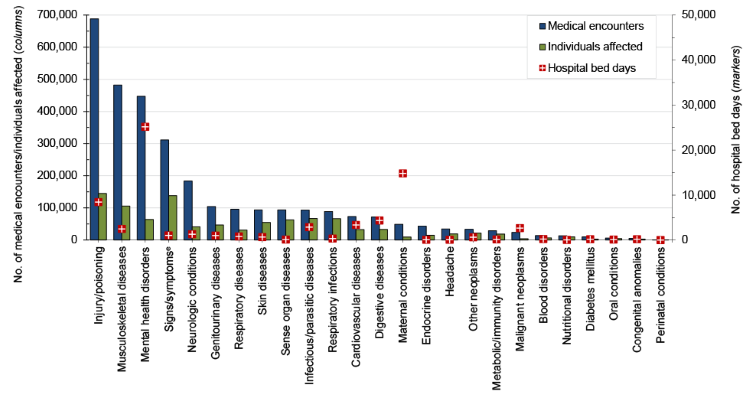Surveillance Snapshot: Illness and Injury Burdens Among Reserve Component Members, U.S. Armed Forces, 2022
 Numbers of medical encounters, individuals affected, and Hospital Bed-Days by Burden of Disease major category, Reserve Component, U.S. Armed Forces, 2022.
Numbers of medical encounters, individuals affected, and Hospital Bed-Days by Burden of Disease major category, Reserve Component, U.S. Armed Forces, 2022.
You also may be interested in...
Article
Apr 1, 2022
Exertional (or exercise-associated) hyponatremia refers to a low serum, plasma, or blood sodium concentration (below 135 mEq/L) that develops during or up to 24 hours following prolonged physical activity. Acute hyponatremia creates an osmotic imbalance between fluids outside and inside of cells.
Article
Apr 1, 2022
Exertional heat illness (hereafter referred to as heat illness) spans a spectrum from relatively mild conditions such as heat cramps and heat exhaustion, to more serious and potentially life-threatening conditions such as heat injury and exertional heat stroke (hereafter heat stroke).
Article
Apr 1, 2022
From 2020 to 2021, the rate of incident heat stroke was relatively stable while the rate of heat exhaustion increased slightly
Article
Apr 1, 2022
Exertional rhabdomyolysis is a potentially serious condition that requires a vigilant and aggressive approach. Some service members who experience exertional rhabdomyolysis may be at risk for recurrences, which may limit their military effectiveness and potentially predispose them to serious injury.
Article
Mar 1, 2022
Since the official introduction of laser refractive surgery into clinical practice throughout the Military Health System (MHS) in fiscal year 2000, these techniques have been heavily implemented in the tri-service community to better equip and improve the readiness of the U.S. military force.
Article
Mar 1, 2022
SARS CoV-2 and the illness it causes, COVID-19, have exacted a heavy toll on the global community. Most of the identified disease has been in the elderly and adults.
The goal of this analysis was to ascertain if user-built ESSENCE queries applied to records of outpatient MHS health care encounters are capable of detecting MIS-C cases that have not ...
Article
Mar 1, 2022
Malaria infection remains an important health threat to U.S. service members who are located in endemic areas because of long-term duty assignments, participation in shorter-term contingency operations, or personal travel. In 2021, a total of 20 service members were diagnosed with or reported to have malaria.
Article
Mar 1, 2022
This study examined monthly prevalence of obesity and exercise in active component U.S. military members prior to and during the COVID-19 pandemic. These results suggest that the COVID-19 pandemic had a small effect on the trend of obesity in the active component U.S. military and that obesity prevalence continues to increase.
Article
Mar 1, 2022
Osteoarthritis (OA) is the most common adult joint disease and predominantly involves the weight-bearing joints. This condition, including spondylosis (OA of the spine), results in significant disability and resource utilization and is a leading cause of medical separation from military service.
Article
Feb 1, 2022
Ocular injuries present an ongoing threat to readiness and retention of service members. This report describes a new approach to categorizing ocular injury using Military Health System data, the application of an algorithm to a dataset, and the verification of the results using an audit of clinical data.
Article
Feb 1, 2022
This snapshot summarizes the total numbers of inpatient and outpatient encounters with an OA or spondylosis diagnosis in the first diagnostic position and the total numbers of unique individuals affected by these conditions during the same 5-year surveillance period.
Article
Feb 1, 2022
Hepatitis C virus (HCV) infection rates are rising in the U.S. despite widely available tools to identify and effectively treat nearly all of these cases. This cross-sectional study aimed to use laboratory data to evaluate the prevalence of HCV diagnoses among active component U.S. military service members.
Article
Jan 1, 2022
This report describes an outbreak of SARS-CoV-2, the causative agent of COVID-19, that peaked during 21–26 Feb. 2021 and was tied to a single military training event. A total of 143 laboratory-confirmed cases were identified.
Article
Jan 1, 2022
This study examined the rates of depressive symptoms in active component U.S. service members prior to and during the COVID-19 pandemic and evaluated whether SARS-CoV-2 test results (positive or negative) were associated with self-reported depressive symptoms.
Article
Jan 1, 2022
Sepsis is a serious and life-threatening organ dysfunction caused by a dysregulated host response to infection. In the U.S., sepsis is a leading cause of in-hospital mortality and 1 of the most expensive conditions treated in U.S. hospitals.
You are leaving Health.mil
The appearance of hyperlinks does not constitute endorsement by the Department of Defense of non-U.S. Government sites or the information, products, or services contained therein. Although the Defense Health Agency may or may not use these sites as additional distribution channels for Department of Defense information, it does not exercise editorial control over all of the information that you may find at these locations. Such links are provided consistent with the stated purpose of this website.
You are leaving Health.mil
View the external links disclaimer.
Last Updated: August 24, 2023